Current Correlations in a Quantum Dot Ring: A Role of Quantum Interference
Abstract
1. Introduction
2. Calculations of Currents and Their Correlations in Triangular Quantum Dot System
2.1. Model
2.2. Calculation of Currents
2.3. Calculation of Current Correlations
3. Bond Currents and Their Correlations: Driven Circular Current in the Case of
4. Persistent Current and Its Noise: The Case
5. Correlation of Persistent and Transport Currents, and
6. Summary
Author Contributions
Funding
Conflicts of Interest
Appendix A. Coupling to Atomic Chain Electrodes: Analytical Results
References and Note
- Webb, R.A.; Washburn, S.; Umbach, C.P.; Laibowitz, R.B. Observation of h/e Aharonov-Bohm Oscillations in Normal-Metal Rings. Phys. Rev. Lett. 1985, 54, 2696–2699. [Google Scholar] [CrossRef]
- Ji, Y.; Chung, Y.; Sprinzak, D.; Heiblum, M.; Mahalu, D.; Shtrikman, H. An electronic Mach-–Zehnder interferometer. Nature 2003, 422, 415–418. [Google Scholar] [CrossRef] [PubMed]
- Cardamone, D.M.; Stafford, C.A.; Mazumdar, S. Controlling Quantum Transport through a Single Molecule. Nano Lett. 2006, 6, 2422–2426. [Google Scholar] [CrossRef]
- Solomon, G.C.; Andrews, D.Q.; Hansen, T.; Goldsmith, R.H.; Wasielewski, M.R.; Van Duyne, R.P.; Ratner, M.A. Understanding quantum interference in coherent molecular conduction. J. Chem. Phys. 2008, 129, 054701. [Google Scholar] [CrossRef] [PubMed]
- Ke, S.H.; Yang, W.; Baranger, H.U. Quantum-Interference-Controlled Molecular Electronics. Nano Lett. 2008, 8, 3257–3261. [Google Scholar] [CrossRef]
- Donarini, A.; Begemann, G.; Grifoni, M. All-Electric Spin Control in Interference Single Electron Transistors. Nano Lett. 2009, 9, 2897–2902. [Google Scholar] [CrossRef][Green Version]
- Rai, D.; Hod, O.; Nitzan, A. Circular currents in molecular wires. J. Phys. Chem. C 2010, 114, 20583–20594. [Google Scholar] [CrossRef]
- Hong, W.; Valkenier, H.; Mészáros, G.; Manrique, D.Z.; Mishchenko, A.; Putz, A.; García, P.M.; Lambert, C.J.; Hummelen, J.C.; Wandlowski, T. An MCBJ case study: The influence of π-conjugation on the single-molecule conductance at a solid/liquid interface. Beilstein J. Nanotechnol. 2011, 2, 699–713. [Google Scholar] [CrossRef] [PubMed]
- Guédon, C.M.; Valkenier, H.; Markussen, T.; Thygesen, K.S.; Hummelen, J.C.; van der Molen, S.J. Observation of quantum interference in molecular charge transport. Nat. Nanotechnol. 2012, 7, 305–309. [Google Scholar] [CrossRef]
- Lambert, C.J. Basic concepts of quantum interference and electron transport in single-molecule electronics. Chem. Soc. Rev. 2015, 44, 875–888. [Google Scholar] [CrossRef]
- Liu, J.; Huang, X.; Wang, F.; Hong, W. Quantum Interference Effects in Charge Transport through Single-Molecule Junctions: Detection, Manipulation, and Application. Accounts Chem. Res. 2019, 52, 151–160. [Google Scholar] [CrossRef]
- Nakanishi, S.; Tsukada, M. Large Loop Current Induced Inside the Molecular Bridge. Jpn. J. Appl. Phys. 1998, 37, L1400–L1402. [Google Scholar] [CrossRef]
- Nakanishi, S.; Tsukada, M. Quantum Loop Current in a C60 Molecular Bridge. Phys. Rev. Lett. 2001, 87, 126801. [Google Scholar] [CrossRef] [PubMed]
- Daizadeh, I.; Guo, J.X.; Stuchebrukhov, A. Vortex structure of the tunneling flow in long-range electron transfer reactions. J. Chem. Phys. 1999, 110, 8865–8868. [Google Scholar] [CrossRef]
- Xue, Y.; Ratner, M.A. Local field effects in current transport through molecular electronic devices: Current density profiles and local nonequilibrium electron distributions. Phys. Rev. B 2004, 70, 081404. [Google Scholar] [CrossRef]
- Stefanucci, G.; Perfetto, E.; Bellucci, S.; Cini, M. Generalized waveguide approach to tight-binding wires: Understanding large vortex currents in quantum rings. Phys. Rev. B 2009, 79, 073406. [Google Scholar] [CrossRef]
- Rai, D.; Hod, O.; Nitzan, A. Magnetic field control of the current through molecular ring junctions. J. Phys. Chem. Lett. 2011, 2, 2118–2124. [Google Scholar] [CrossRef]
- Rai, D.; Hod, O.; Nitzan, A. Magnetic fields effects on the electronic conduction properties of molecular ring structures. Phys. Rev. B 2012, 85, 155440. [Google Scholar] [CrossRef]
- Yadalam, H.K.; Harbola, U. Controlling local currents in molecular junctions. Phys. Rev. B 2016, 94, 115424. [Google Scholar] [CrossRef]
- Nozaki, D.; Schmidt, W.G. Current density analysis of electron transport through molecular wires in open quantum systems. J. Comput. Chem. 2017, 38, 1685–1692. [Google Scholar] [CrossRef] [PubMed]
- Patra, M.; Maiti, S.K. Modulation of circular current and associated magnetic field in a molecular junction: A new approach. Sci. Rep. 2017, 7, 43343. [Google Scholar] [CrossRef] [PubMed]
- Cabra, G.; Jensen, A.; Galperin, M. On simulation of local fluxes in molecular junctions. J. Chem. Phys. 2018, 148, 204103. [Google Scholar] [CrossRef] [PubMed]
- Moskalets, M.V. Temperature-induced current in a one-dimensional ballistic ring with contacts. Europhys. Lett. (EPL) 1998, 41, 189–194. [Google Scholar] [CrossRef]
- Chung, V.S.W.; Samuelsson, P.; Buttiker, M. Visibility of current and shot noise in electrical Mach-Zehnder and Hanbury Brown Twiss interferometers. Phys. Rev. B 2005, 72, 125320. [Google Scholar] [CrossRef]
- Büttiker, M.; Samuelsson, P. Interference of independently emitted electrons in quantum shot noise. Ann. Phys. 2007, 16, 751–766. [Google Scholar] [CrossRef]
- Pilgram, S.; Samuelsson, P.; Förster, H.; Büttiker, M. Full-Counting Statistics for Voltage and Dephasing Probes. Phys. Rev. Lett. 2006, 97, 066801. [Google Scholar] [CrossRef]
- Förster, H.; Pilgram, S.; Büttiker, M. Decoherence and full counting statistics in a Mach-Zehnder interferometer. Phys. Rev. B 2005, 72, 075301. [Google Scholar] [CrossRef]
- Förster, H.; Samuelsson, P.; Pilgram, S.; Büttiker, M. Voltage and dephasing probes in mesoscopic conductors: A study of full-counting statistics. Phys. Rev. B 2007, 75, 035340. [Google Scholar] [CrossRef]
- Bauerle, C.; Glattli, D.C.; Meunier, T.; Portier, F.; Roche, P.; Roulleau, P.; Takada, S.; Waintal, X. Coherent control of single electrons: A review of current progress. Rep. Prog. Phys. 2018, 81, 056503. [Google Scholar] [CrossRef] [PubMed]
- Lesovik, G.B. Excess quantum noise in two-dimensional ballistic microcontacts. Pis’ma Zh. Eksp. Teor. Fiz. 1989, 49, 513–515. [Google Scholar]
- Haug, H.; Jauho, A.P. Quantum Kinetics in Transport and Optics of Semiconductors; Springer: Berlin/Heidelberg, Germany, 2008. [Google Scholar]
- Blanter, Y.; Büttiker, M. Shot noise in mesoscopic conductors. Phys. Rep. 2000, 336, 1–166. [Google Scholar] [CrossRef]
- Levitov, L.S.; Lesovik, G.B. Charge-transport statistics in quantum conductors. Pis’ma Zh. Eksp. Teor. Fiz. 1992, 55, 534–537. [Google Scholar]
- Lesovik, G.B.; Sadovskyy, I.A. Scattering matrix approach to the description of quantum electron transport. Physics-Uspekhi 2011, 54, 1007–1059. [Google Scholar] [CrossRef]
- Martin, T.; Landauer, R. Wave-packet approach to noise in multichannel mesoscopic systems. Phys. Rev. B 1992, 45, 1742–1755. [Google Scholar] [CrossRef]
- Jayannavar, A.M.; Singha Deo, P. Persistent currents in the presence of a transport current. Phys. Rev. B 1995, 51, 10175–10178. [Google Scholar] [CrossRef]
- One can define the driven current as [7]: Idr=(I12l12-I13l13)/(l12+l13), where l12,l13 denotes the length of the upper and the lower branch. For I13→0 one gets a finite circular current, what is an artefact.
- Bułka, B.R. Current and power spectrum in a magnetic tunnel device with an atomic-size spacer. Phys. Rev. B 2000, 62, 1186–1192. [Google Scholar] [CrossRef]
- Büttiker, M.; Stafford, C.A. Charge Transfer Induced Persistent Current and Capacitance Oscillations. Phys. Rev. Lett. 1996, 76, 495–498. [Google Scholar] [CrossRef]
- Cedraschi, P.; Büttiker, M. Suppression of level hybridization due to Coulomb interactions. J. Phys. Condens. Matter 1998, 10, 3985–4000. [Google Scholar] [CrossRef][Green Version]
- Cedraschi, P.; Ponomarenko, V.V.; Büttiker, M. Zero-Point Fluctuations and the Quenching of the Persistent Current in Normal Metal Rings. Phys. Rev. Lett. 2000, 84, 346–349. [Google Scholar] [CrossRef]
- Cedraschi, P.; Buttiker, M. Zero-point fluctuations in the ground state of a mesoscopic normal ring. Ann. Phys. 2000, 289, 165312. [Google Scholar] [CrossRef]
- Semenov, A.G.; Zaikin, A.D. Fluctuations of persistent current. J. Phys. Condens. Matter 2010, 22, 485302. [Google Scholar] [CrossRef][Green Version]
- Semenov, A.G.; Zaikin, A.D. Persistent current noise and electron-electron interactions. Phys. Rev. B 2011, 84, 045416. [Google Scholar] [CrossRef]
- Semenov, A.G.; Zaikin, A.D. Persistent currents in quantum phase slip rings. Phys. Rev. B 2013, 88, 054505. [Google Scholar] [CrossRef]
- Semenov, A.G.; Zaikin, A.D. Quantum phase slip noise. Phys. Rev. B 2016, 94, 014512. [Google Scholar] [CrossRef]
- Moskalets, M. Persistent currents in ballistic normal-metal rings. Low Temp. Phys. 2010, 36, 982–989. [Google Scholar] [CrossRef]
- Komnik, A.; Langhanke, G.W. Full counting statistics of persistent current. Phys. Rev. B 2014, 90, 165107. [Google Scholar] [CrossRef]
- Saha, M.; Maiti, S.K. Circulating current in 1D Hubbard rings with long-range hopping: Comparison between exact diagonalization method and mean-field approach. Phys. E Low-Dimens. Syst. Nanostruct. 2016, 84, 118–134. [Google Scholar] [CrossRef]
- Imry, Y. Introduction to Mesoscopic Physics; Oxford University Press: New York, NY, USA, 1997. [Google Scholar]
- Cheung, H.F.; Gefen, Y.; Riedel, E.K.; Shih, W.H. Persistent currents in small one-dimensional metal rings. Phys. Rev. B 1988, 37, 6050–6062. [Google Scholar] [CrossRef]
- Nazarov, Y.V.; Blanter, Y.M. Quantum Transport: Introduction to Nanoscience; Cambridge University Press: Cambridge, UK, 2009. [Google Scholar] [CrossRef]
- Schoeller, H.; Schön, G. Mesoscopic quantum transport: Resonant tunneling in the presence of a strong Coulomb interaction. Phys. Rev. B 1994, 50, 18436–18452. [Google Scholar] [CrossRef]
- König, J.; Schmid, J.; Schoeller, H.; Schön, G. Resonant tunneling through ultrasmall quantum dots: Zero-bias anomalies, magnetic-field dependence, and boson-assisted transport. Phys. Rev. B 1996, 54, 16820–16837. [Google Scholar] [CrossRef]
- Thielmann, A.; Hettler, M.H.; König, J.; Schön, G. Cotunneling Current and Shot Noise in Quantum Dots. Phys. Rev. Lett. 2005, 95, 146806. [Google Scholar] [CrossRef] [PubMed]
- Kamenev, A. Field Theory of Non-Equilibrium Systems; Cambridge University Press: Cambridge, UK, 2011. [Google Scholar] [CrossRef]
- Gogolin, A.O.; Komnik, A. Towards full counting statistics for the Anderson impurity model. Phys. Rev. B 2006, 73, 195301. [Google Scholar] [CrossRef]

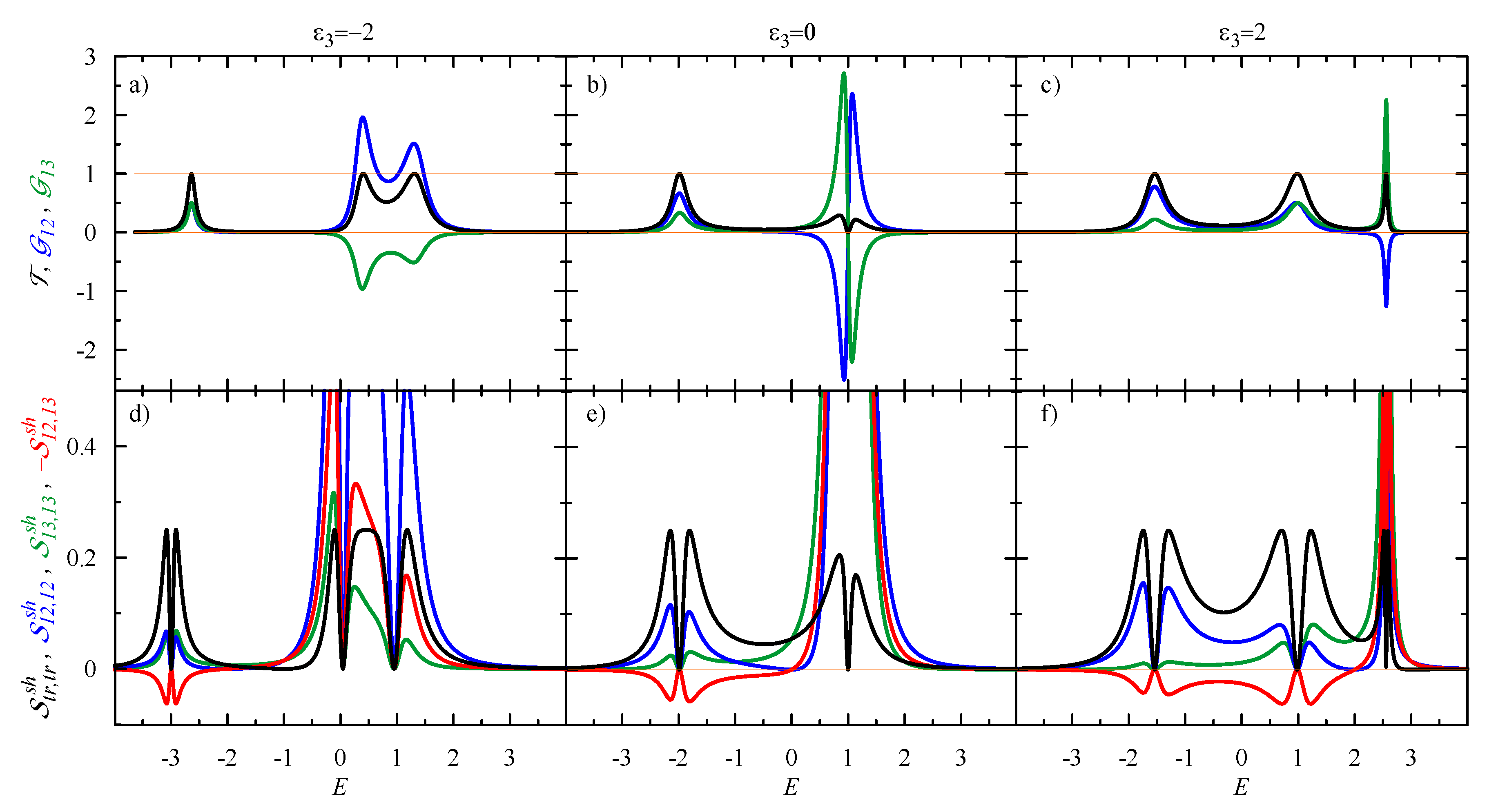
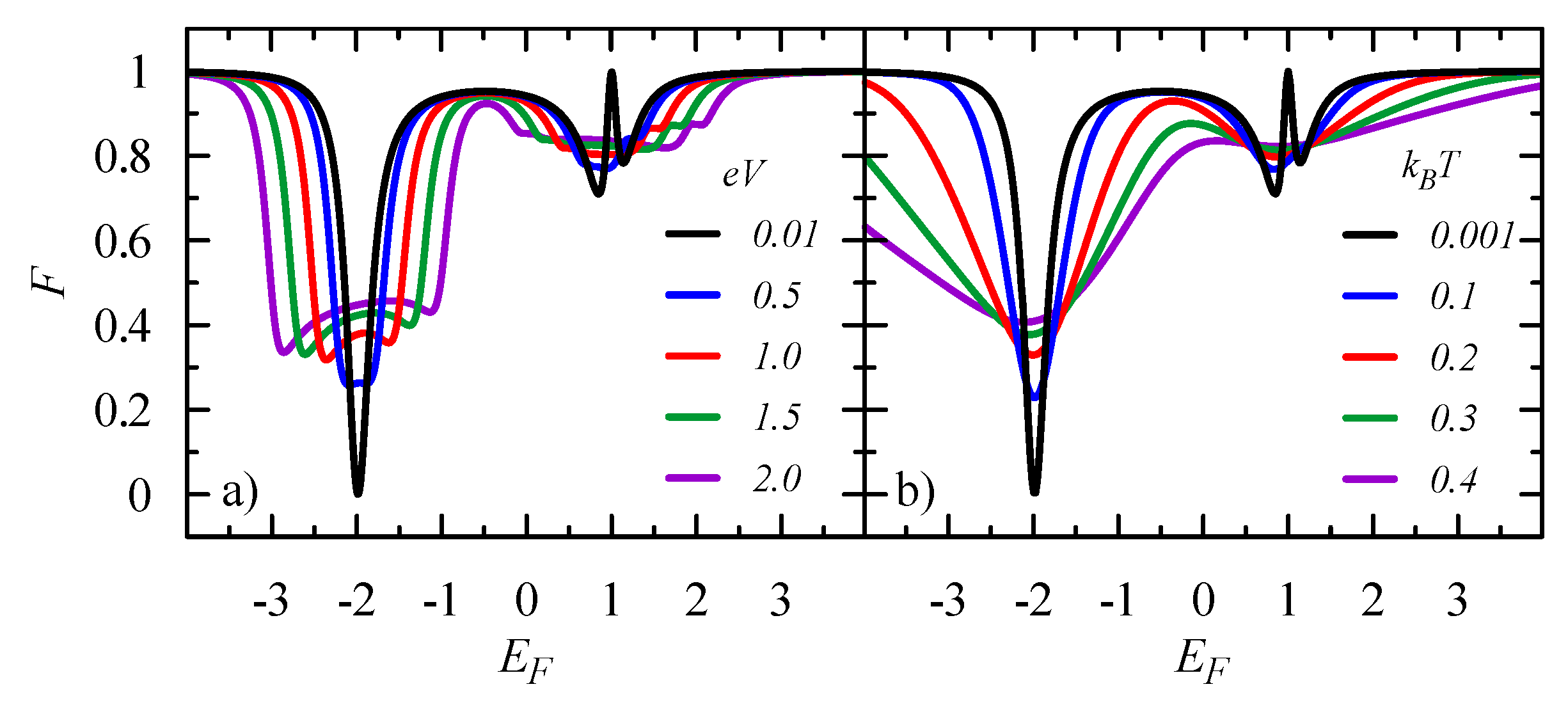
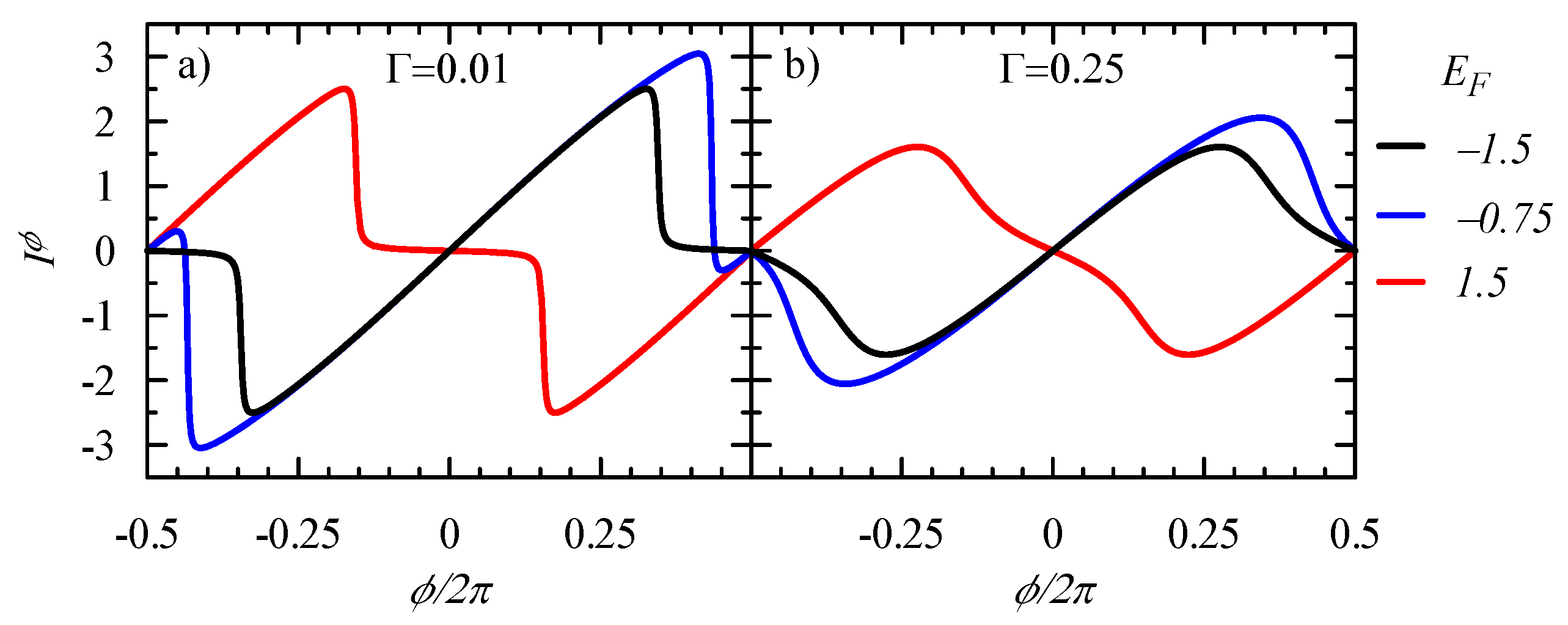
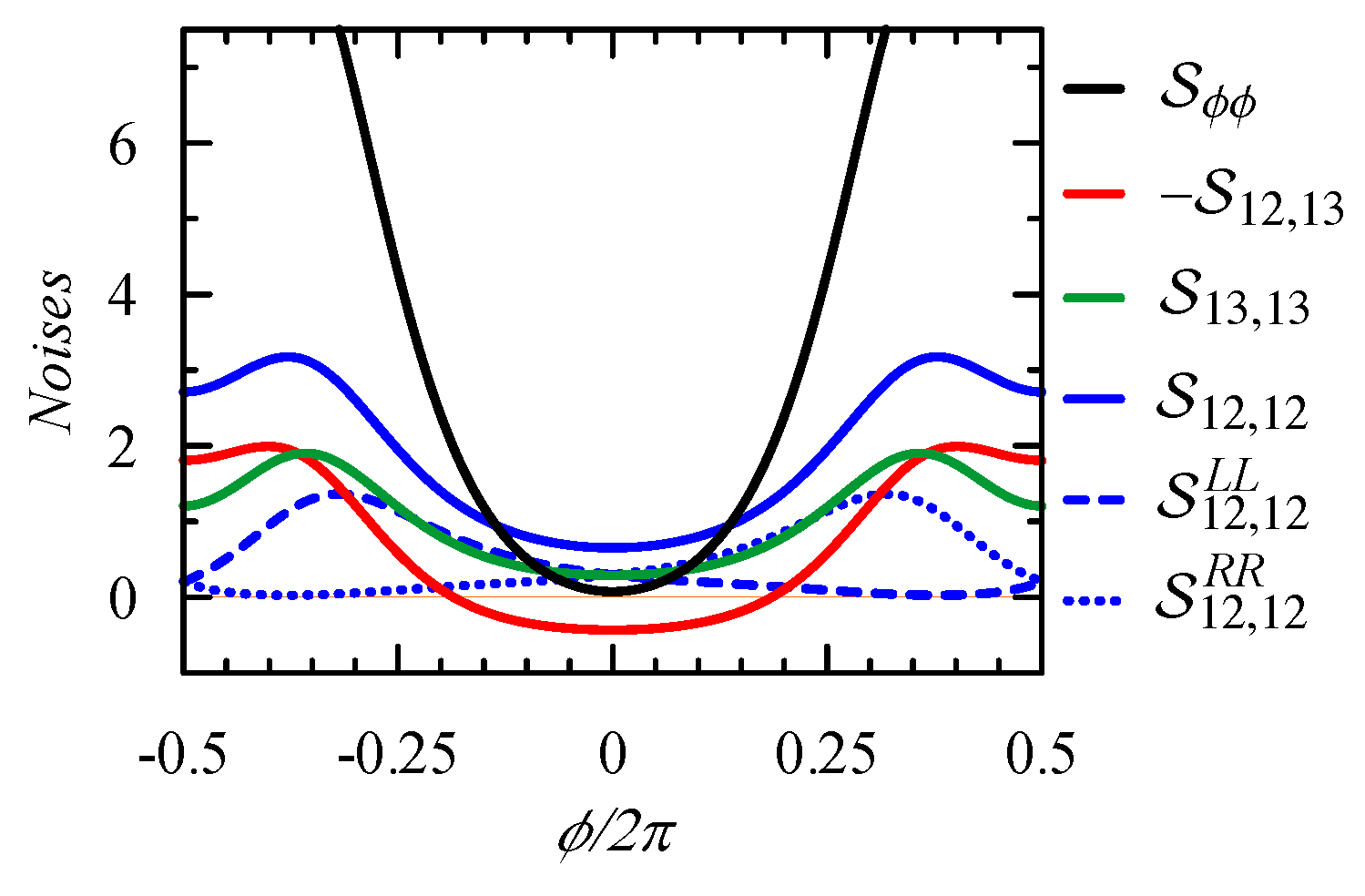
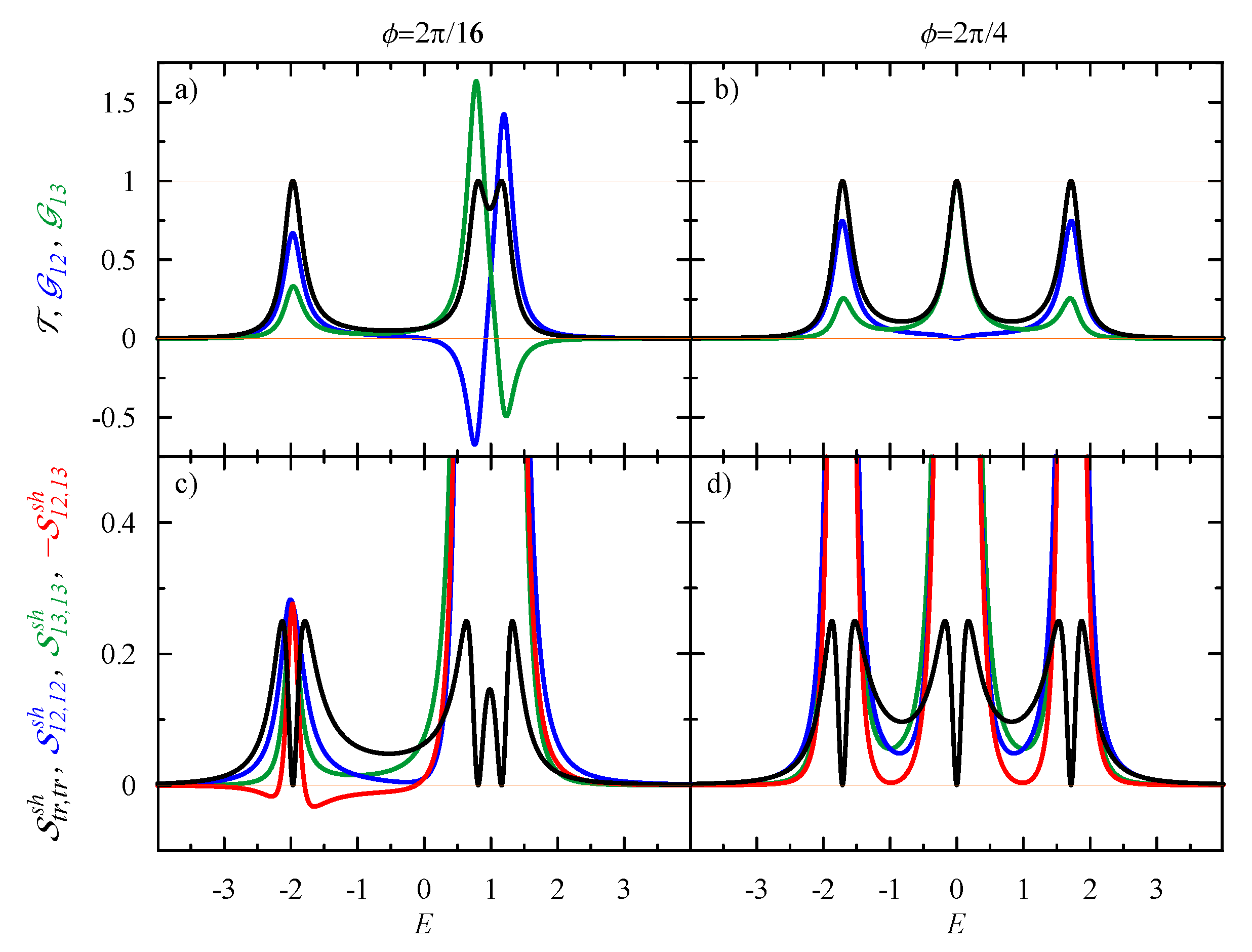
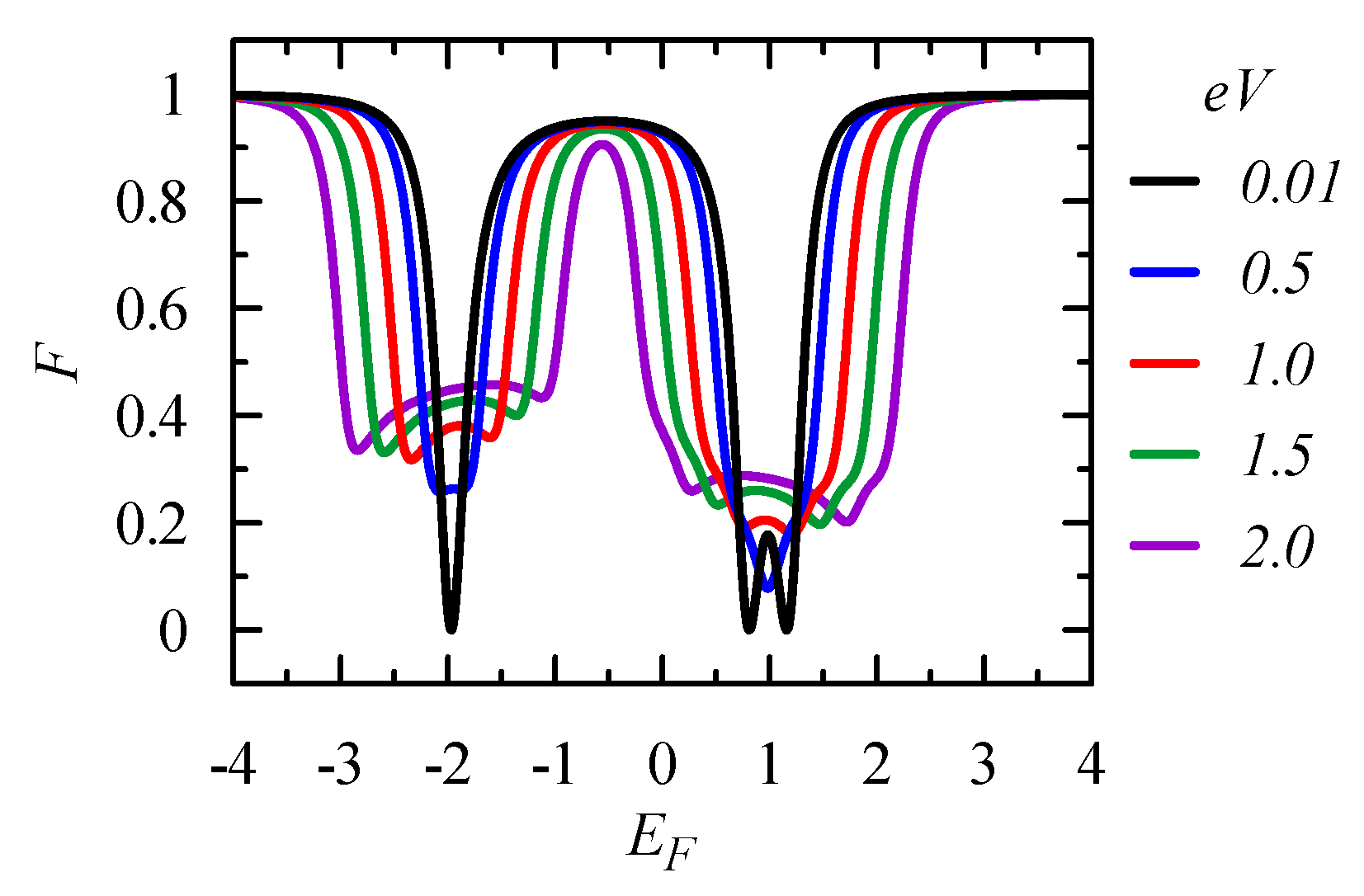
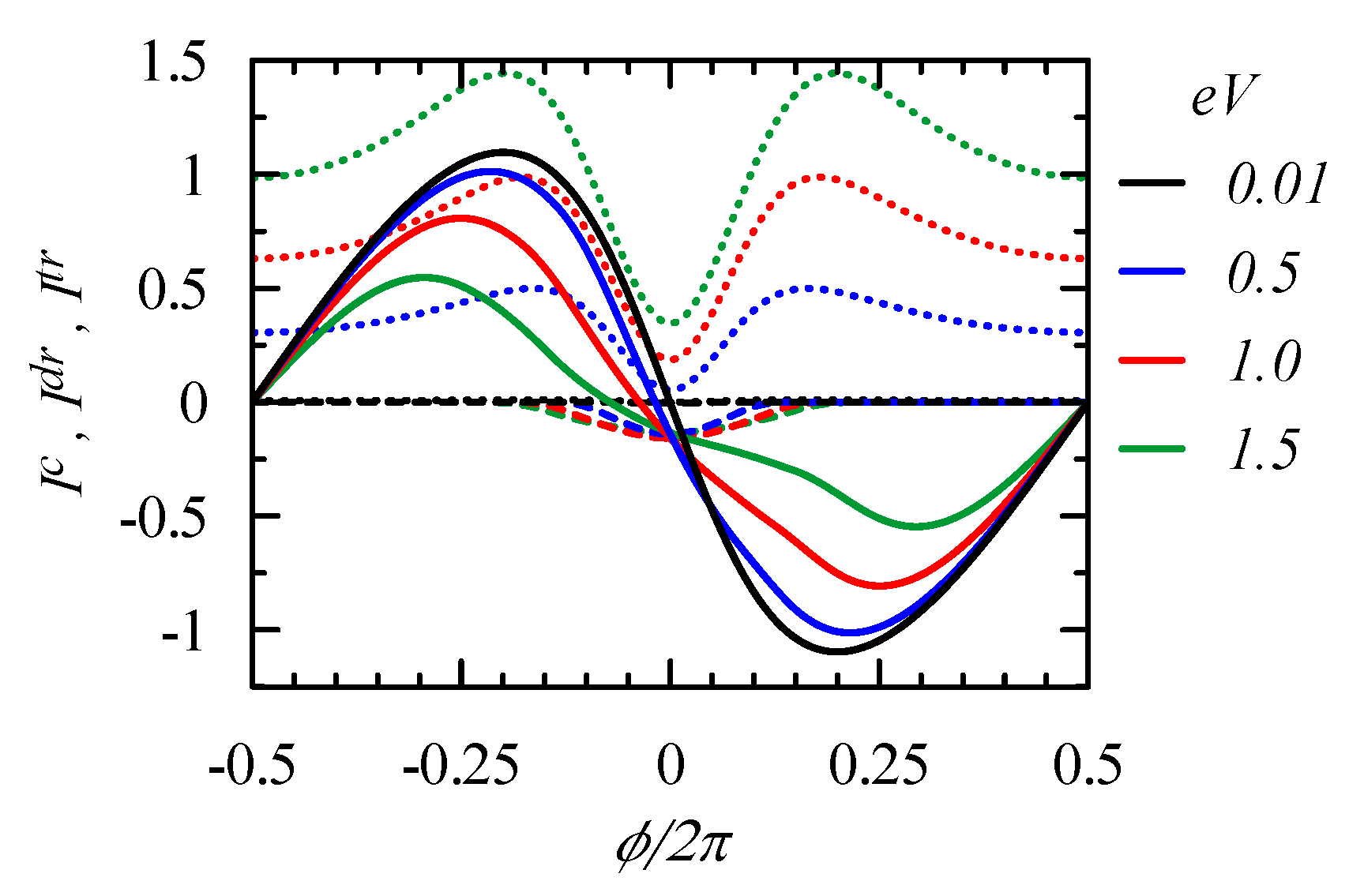
© 2019 by the authors. Licensee MDPI, Basel, Switzerland. This article is an open access article distributed under the terms and conditions of the Creative Commons Attribution (CC BY) license (http://creativecommons.org/licenses/by/4.0/).
Share and Cite
Bułka, B.R.; Łuczak, J. Current Correlations in a Quantum Dot Ring: A Role of Quantum Interference. Entropy 2019, 21, 527. https://doi.org/10.3390/e21050527
Bułka BR, Łuczak J. Current Correlations in a Quantum Dot Ring: A Role of Quantum Interference. Entropy. 2019; 21(5):527. https://doi.org/10.3390/e21050527
Chicago/Turabian StyleBułka, Bogdan R., and Jakub Łuczak. 2019. "Current Correlations in a Quantum Dot Ring: A Role of Quantum Interference" Entropy 21, no. 5: 527. https://doi.org/10.3390/e21050527
APA StyleBułka, B. R., & Łuczak, J. (2019). Current Correlations in a Quantum Dot Ring: A Role of Quantum Interference. Entropy, 21(5), 527. https://doi.org/10.3390/e21050527




